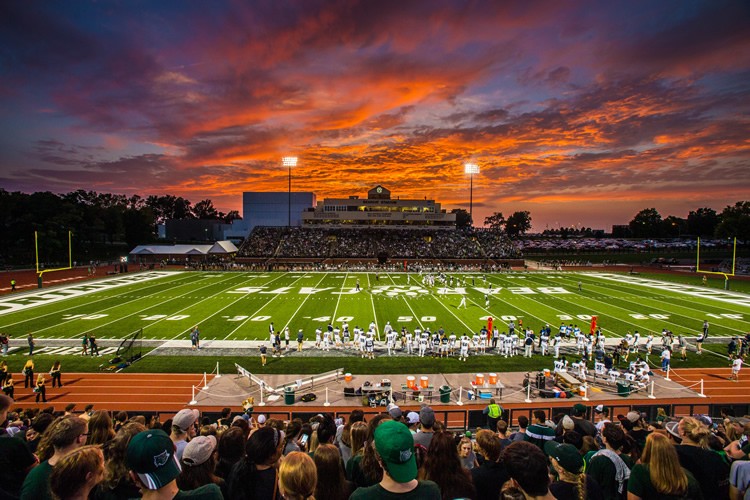Bearcat Stadium
Introduction
Text-to-speech Audio
Bearcat Stadium is a beloved and iconic landmark at Northwest Missouri State University, and it is not hard to see why. The stadium is more than just a place to watch football games - it is a symbol of school spirit and community pride. For generations, students and fans have come together in the stadium to cheer on the Bearcats and celebrate the rich history of Northwest Missouri State football.
The legacy of successful football at Northwest is proudly displayed throughout the stadium. The walls are adorned with plaques and photos commemorating championship seasons and standout players. The stadium's field is meticulously maintained, with the Bearcat logo prominently displayed at midfield. The stadium's seating capacity has grown over the years, from just a few hundred in the early days to over 6,500 today.
For many students, their first experience of Bearcat Stadium comes during SOAR week, the university's orientation program for new students. During this week, students are taught all of the football chants and cheers that will be heard throughout the season. This creates a sense of camaraderie and excitement among the students, who look forward to attending games and supporting their team.
On game days, the stadium is packed with fans dressed in green and white, the school's colors. The atmosphere is electric, with the crowd cheering and chanting in unison. One of the unique traditions at Bearcat Stadium is the firing of a cannon by the men of Phi Sigma Kappa every time the Bearcats score a touchdown. This adds to the excitement and energy of the game, and is a favorite among fans.
At the end of a successful season, the students of Northwest Missouri State have a tradition of tearing down the goalposts and carrying them across campus to be cut up. Many students have a small piece of a goalpost as a cherished souvenir of their time at the university.
When football season ends, the stadium is not forgotten. On beautiful days, students can be found exercising or hanging out on the turf. The stadium is also home to several popular intramural sports, including soccer and flag football. This ensures that the stadium remains a vibrant and important part of campus life throughout the year.
In short, Bearcat Stadium is more than just a place to watch football - it is a symbol of the pride and spirit of Northwest Missouri State University.
Images
Bearcat Stadium

Backstory and Context
Text-to-speech Audio
Bearcat Stadium is a centerpiece of Northwest Missouri State University's campus and has a rich history dating back to the 1930s. The original stadium, named after professor and football coach W.T. Rickenbrode, was built in 1937 and had a seating capacity of 4,000. It was located on the east side of the campus, across from where the current stadium is located.
In the early 1960s, Northwest's football program began to see a resurgence in success, which led to increased demand for a larger and more modern stadium. Plans for a new stadium began to take shape in 1967, and construction started in 1969. The new stadium was built on the west side of campus, where it currently stands, and was completed in 1971.
The new stadium was named after J.W. Jones, the university's president at the time, and had a seating capacity of 5,000. It featured a grass playing surface, a cinder track, and basic bleacher-style seating. Over the next several decades, various improvements and renovations were made to the stadium, including the installation of lights in 1990 and the addition of a press box and VIP seating in 1992.
However, by the late 1990s, it became clear that the stadium needed significant upgrades to keep up with the demands of a modern football program. The east grandstand and southeast ticket houses were renovated in 2000 to enhance customer service, but more significant improvements were needed.
In 2002-2003, major renovations took place that completely transformed the stadium. The old west grandstand and press box were torn down and replaced with an enlarged facility that featured chairback, tailback, and traditional seating, as well as 10 luxury suites, an upper media/coaching area, and a filming tower. A new scoreboard with video replay capabilities was also installed.
The stadium was renamed Bearcat Stadium in 2004 to honor the Northwest family members who helped fund the new structures and additional facilities. The upgrades continued in 2007 when the natural grass playing surface was replaced with artificial turf, and the stadium was officially renamed Tjeerdsma Field to honor the success of former head football coach Melvin L. Tjeerdsma. Lights were also added to the stadium, allowing for night games and practices.
Today, Bearcat Stadium is a state-of-the-art facility that serves as a source of pride for the university and the Maryville community. It is not only the home of the Bearcat football team but also hosts other athletic events, concerts, and community gatherings throughout the year. The Herschel Neil Track that surrounds the field is a testament to the university's commitment to athletic excellence, and the stadium's capacity of 7,500 ensures that there is plenty of room for fans to cheer on their favorite teams. Bearcat Stadium is truly a symbol of Northwest Missouri State University's past, present, and future.
Sources
Bearcat Stadium, Wikipedia . November 29th, 2021. Accessed April 5th, 2023. https://en.wikipedia.org/wiki/Bearcat_Stadium.
Northwest Missouri State Media
